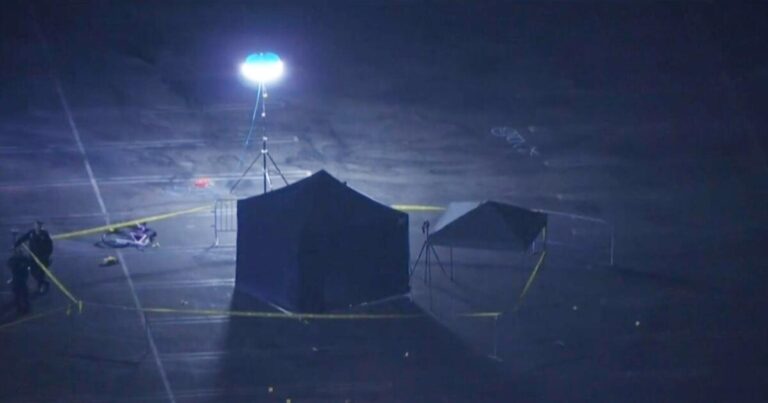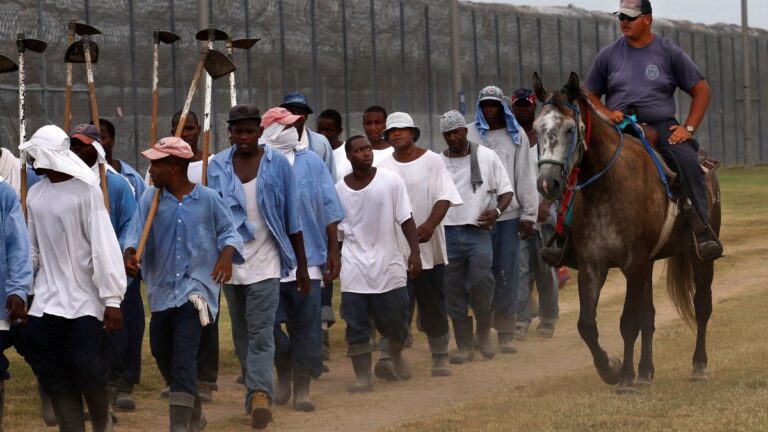A hidden path to America’s dinner tables begins here, at an unlikely source – a former Southern slave plantation that is now the country’s largest maximum-security prison.
Unmarked trucks packed with prison-raised cattle roll out of the Louisiana State Penitentiary, where men are sentenced to hard labor and forced to work, for pennies an hour or sometimes nothing at all. After rumbling down a country road to an auction house, the cows are bought by a local rancher and then followed by The Associated Press another 600 miles to a Texas slaughterhouse that feeds into the supply chains of giants like McDonald’s, Walmart and Cargill.
Intricate, invisible webs, just like this one, link some of the world’s largest food companies and most popular brands to jobs performed by U.S. prisoners nationwide, according to a sweeping two-year AP investigation into prison labor that tied hundreds of millions of dollars worth of agricultural products to goods sold on the open market.
They are among America’s most vulnerable laborers. If they refuse to work, some can jeopardize their chances of parole or face punishment like being sent to solitary confinement. They also are often excluded from protections guaranteed to almost all other full-time workers, even when they are seriously injured or killed on the job.
The goods these prisoners produce wind up in the supply chains of a dizzying array of products found in most American kitchens, from Frosted Flakes cereal and Ball Park hot dogs to Gold Medal flour, Coca-Cola and Riceland rice. They are on the shelves of virtually every supermarket in the country, including Kroger, Target, Aldi and Whole Foods. And some goods are exported, including to countries that have had products blocked from entering the U.S. for using forced or prison labor.
Many of the companies buying directly from prisons are violating their own policies against the use of such labor. But it’s completely legal, dating back largely to the need for labor to help rebuild the South’s shattered economy after the Civil War. Enshrined in the Constitution by the 13th Amendment, slavery and involuntary servitude are banned – except as punishment for a crime.
That clause is currently being challenged on the federal level, and efforts to remove similar language from state constitutions are expected to reach the ballot in about a dozen states this year.
Some prisoners work on the same plantation soil where slaves harvested cotton, tobacco and sugarcane more than 150 years ago, with some present-day images looking eerily similar to the past. In Louisiana, which has one of the country’s highest incarceration rates, men working on the “farm line” still stoop over crops stretching far into the distance.
Willie Ingram picked everything from cotton to okra during his 51 years in the state penitentiary, better known as Angola.
During his time in the fields, he was overseen by armed guards on horseback and recalled seeing men, working with little or no water, passing out in triple-digit heat. Some days, he said, workers would throw their tools in the air to protest, despite knowing the potential consequences.
“They’d come, maybe four in the truck, shields over their face, billy clubs, and they’d beat you right there in the field. They beat you, handcuff you and beat you again,” said Ingram, who received a life sentence after pleading guilty to a crime he said he didn’t commit. He was told he would serve 10 ½ years and avoid a possible death penalty, but it wasn’t until 2021 that a sympathetic judge finally released him. He was 73.
The number of people behind bars in the United States started to soar in the 1970s just as Ingram entered the system, disproportionately hitting people of color. Now, with about 2 million people locked up, U.S. prison labor from all sectors has morphed into a multibillion-dollar empire, extending far beyond the classic images of prisoners stamping license plates, working on road crews or battling wildfires.
Though almost every state has some kind of farming program, agriculture represents only a small fraction of the overall prison workforce. Still, an analysis of data amassed by the AP from correctional facilities nationwide traced nearly $200 million worth of sales of farmed goods and livestock to businesses over the past six years – a conservative figure that does not include tens of millions more in sales to state and government entities. Much of the data provided was incomplete, though it was clear that the biggest revenues came from sprawling operations in the South and leasing out prisoners to companies.
Corrections officials and other proponents note that not all work is forced and that prison jobs save taxpayers money. For example, in some cases, the food produced is served in prison kitchens or donated to those in need outside. They also say workers are learning skills that can be used when they’re released and given a sense of purpose, which could help ward off repeat offenses. In some places, it allows prisoners to also shave time off their sentences. And the jobs provide a way to repay a debt to society, they say.
While most critics don’t believe all jobs should be eliminated, they say incarcerated people should be paid fairly, treated humanely and that all work should be voluntary. Some note that even when people get specialized training, like firefighting, their criminal records can make it almost impossible to get hired on the outside.
“They are largely uncompensated, they are being forced to work, and it’s unsafe. They also aren’t learning skills that will help them when they are released,” said law professor Andrea Armstrong, an expert on prison labor at Loyola University New Orleans. “It raises the question of why we are still forcing people to work in the fields.”
A SHADOW WORKFORCE WITH FEW PROTECTIONS
In addition to tapping a cheap, reliable workforce, companies sometimes get tax credits and other financial incentives. Incarcerated workers also typically aren’t covered by the most basic protections, including workers’ compensation and federal safety standards. In many cases, they cannot file official complaints about poor working conditions.
These prisoners often work in industries with severe labor shortages, doing some of the country’s dirtiest and most dangerous jobs.
The AP sifted through thousands of pages of documents and spoke to more than 80 current or formerly incarcerated people, including men and women convicted of crimes that ranged from murder to shoplifting, writing bad checks, theft or other illegal acts linked to drug use. Some were given long sentences for nonviolent offenses because they had previous convictions, while others were released after proving their innocence.
Reporters found people who were hurt or maimed on the job, and also interviewed women who were sexually harassed or abused, sometimes by their civilian supervisors or the correctional officers overseeing them. While it’s often nearly impossible for those involved in workplace accidents to sue, the AP examined dozens of cases that managed to make their way into the court system. Reporters also spoke to family members of prisoners who were killed.
One of those was Frank Dwayne Ellington, who was sentenced to life in prison with the possibility of parole after stealing a man’s wallet at gunpoint – a result of Alabama’s habitual offenders act. In 2017, Ellington, 33, was cleaning a machine near the chicken “kill line” in Ashland at Koch Foods – one of the country’s biggest poultry-processing companies – when its whirling teeth caught his arm and sucked him inside, crushing his skull. He died instantly.
During a yearslong legal battle, Koch Foods at first argued Ellington wasn’t technically an employee, and later said his family should be barred from filing for wrongful death because the company had paid his funeral expenses. The case eventually was settled under undisclosed terms. The Occupational Safety and Health Administration fined the company $19,500, saying workers had not been given proper training and that its machines had inadequate safety guards.
“It’s somebody’s child, it’s somebody’s dad, it’s somebody’s uncle, it’s somebody’s family,” said Ellington’s mother, Alishia Powell-Clark. “Yes, they did wrong, but they are paying for it.”
The AP found that U.S. prison labor is in the supply chains of goods being shipped all over the world via multinational companies, including to countries that have been slapped with import bans by Washington in recent years. For instance, the U.S. has blocked shipments of cotton coming from China, a top manufacturer of popular clothing brands, because it was produced by forced or prison labor. But crops harvested by U.S. prisoners have entered the supply chains of companies that export to China.
While prison labor seeps into the supply chains of some companies through third-party suppliers without them knowing, others buy direct. Mammoth commodity traders that are essential to feeding the globe like Cargill, Bunge, Louis Dreyfus, Archer Daniels Midland and Consolidated Grain and Barge – which together post annual revenues of more than $400 billion – have in recent years scooped up millions of dollars’ worth of soy, corn and wheat straight from prisons, which compete with local farmers.
The AP reached out for comment to the companies it identified as having connections to prison labor, but most did not respond.
Cargill acknowledged buying goods from prison farms in Tennessee, Arkansas and Ohio, saying they constituted only a small fraction of the company’s overall volume. It added that “we are now in the process of determining the appropriate remedial action.”
McDonald’s said it would investigate links to any such labor, while Archer Daniels Midland and General Mills, which produces Gold Medal flour, pointed to their policies in place restricting suppliers from using forced labor. Whole Foods responded flatly: “Whole Foods Market does not allow the use of prison labor in products sold at our stores.”
Bunge said it sold all facilities that were sourcing from correction departments in 2021, so they are “no longer part of Bunge’s footprint.”
Dairy Farmers of America, a cooperative that bills itself as the top supplier of raw milk worldwide, said that while it has been buying from correctional facilities, it now only has one “member dairy” at a prison, with most of that milk used inside.
To understand the business of prison labor and the complex movement of agricultural goods, the AP collected information from all 50 states, through public records requests and inquiries to corrections departments. Reporters also crisscrossed the country, following trucks transporting crops and livestock linked to prison work, and tailed transport vans from prisons and work-release sites heading to places such as poultry plants, egg farms and fast-food restaurants. A lack of transparency and, at times, baffling losses exposed in audits, added to the challenges of fully tracking the money.
Big-ticket items like row crops and livestock are sold on the open market, with profits fed back into agriculture programs. For instance, about a dozen state prison farms, including operations in Texas, Virginia, Kentucky and Montana, have sold more than $60 million worth of cattle since 2018.
As with other sales, the custody of cows can take a serpentine route. Because they often are sold online at auction houses or to stockyards, it can be almost impossible to determine where the beef eventually ends up.
Sometimes there’s only one way to know for sure.
In Louisiana, an AP reporter watched as three long trailers loaded with more than 80 cattle left the state penitentiary. The cows raised by prisoners traveled for about an hour before being unloaded for sale at Dominique’s Livestock Market in Baton Rouge.
As they were shoved through a gate into a viewing pen, the auctioneer jokingly warned buyers “Watch out!” The cows, he said, had just broken out of prison.
Within minutes, the Angola lot was snapped up by a local livestock dealer, who then sold the cattle to a Texas beef processor that also buys cows directly from prisons in that state. Meat from the slaughterhouse winds up in the supply chains of some of the country’s biggest fast-food chains, supermarkets and meat exporters, including Burger King, Sam’s Club and Tyson Foods.
“It’s a real slap in the face, to hear where all those cattle are going,” said Jermaine Hudson, who served 22 years at Angola on a robbery conviction before he was exonerated.
He said it’s especially galling because the food served in prison tasted like slop.
“Those were some of the most disrespectful meals,” Hudson said, “that I ever, in my life, had to endure.”
THE RISE OF PRISON LABOR
Angola is imposing in its sheer scale. The so-called “Alcatraz of the South” is tucked far away, surrounded by crocodile-infested swamps in a bend of the Mississippi River. It spans 18,000 acres – an area bigger than the island of Manhattan – and has its own ZIP code.
The former 19th-century antebellum plantation once was owned by one of the largest slave traders in the U.S. Today, it houses some 3,800 men behind its razor-wire walls, about 65 percent of them Black. Within days of arrival, they typically head to the fields, sometimes using hoes and shovels or picking crops by hand. They initially work for free, but then can earn between 2 cents and 40 cents an hour.
Calvin Thomas, who spent more than 17 years at Angola, said anyone who refused to work, didn’t produce enough or just stepped outside the long straight rows knew there would be consequences.
“If he shoots the gun in the air because you done passed that line, that means you’re going to get locked up and you’re going to have to pay for that bullet that he shot,” said Thomas, adding that some days were so blistering hot the guards’ horses would collapse.
“You can’t call it anything else,” he said. “It’s just slavery.”
Louisiana corrections spokesman Ken Pastorick called that description “absurd.” He said the phrase “sentenced with hard labor” is a legal term referring to a prisoner with a felony conviction.
Pastorick said the department has transformed Angola from “the bloodiest prison in America” over the past several decades with “large-scale criminal justice reforms and reinvestment into the creation of rehabilitation, vocational and educational programs designed to help individuals better themselves and successfully return to communities.” He noted that pay rates are set by state statute.
Current and former prisoners in both Louisiana and Alabama have filed class-action lawsuits in the past four months saying they have been forced to provide cheap – or free – labor to those states and outside companies, a practice they also described as slavery.
Prisoners have been made to work since before emancipation, when slaves were at times imprisoned and then leased out by local authorities.
But after the Civil War, the 13th Amendment’s exception clause that allows for prison labor provided legal cover to round up thousands of mostly young Black men. Many were jailed for petty offenses like loitering and vagrancy. They then were leased out by states to plantations like Angola and some of the country’s biggest companies, including coal mines and railroads. They were routinely whipped for not meeting quotas while doing brutal and often deadly work.
The convict-leasing period, which officially ended in 1928, helped chart the path to America’s modern-day prison-industrial complex.
Incarceration was used not just for punishment or rehabilitation but for profit. A law passed a few years later made it illegal to knowingly transport or sell goods made by incarcerated workers across state lines, though an exception was made for agricultural products. Today, after years of efforts by lawmakers and businesses, corporations are setting up joint ventures with corrections agencies, enabling them to sell almost anything nationwide.
Civilian workers are guaranteed basic rights and protections by OSHA and laws like the Fair Labor Standards Act, but prisoners, who are often not legally considered employees, are denied many of those entitlements and cannot protest or form unions.
“They may be doing the exact same work as people who are not incarcerated, but they don’t have the training, they don’t have the experience, they don’t have the protective equipment,” said Jennifer Turner, lead author of a 2022 American Civil Liberties Union report on prison labor.
Almost all of the country’s state and federal adult prisons have some sort of work program, employing around 800,000 people, the report said. It noted the vast majority of those jobs are connected to tasks like maintaining prisons, laundry or kitchen work, which typically pay a few cents an hour if anything at all. And the few who land the highest-paying state industry jobs may earn only a dollar an hour.
Altogether, labor tied specifically to goods and services produced through state prison industries brought in more than $2 billion in 2021, the ACLU report said. That includes everything from making mattresses to solar panels, but does not account for work-release and other programs run through local jails, detention and immigration centers and even drug and alcohol rehabilitation facilities.
Some incarcerated workers with just a few months or years left on their sentences have been employed everywhere from popular restaurant chains like Burger King to major retail stores and meat-processing plants. Unlike work crews picking up litter in orange jumpsuits, they go largely unnoticed, often wearing the same uniforms as their civilian counterparts.
Outside jobs can be coveted because they typically pay more and some states deposit a small percentage earned into a savings account for prisoners’ eventual release. Though many companies pay minimum wage, some states garnish more than half their salaries for items such as room and board and court fees.
It’s a different story for those on prison farms. The biggest operations remain in the South and crops are still harvested on a number of former slave plantations, including in Arkansas, Texas and at Mississippi’s notorious Parchman Farm. Those states, along with Florida, Alabama, South Carolina and Georgia, pay nothing for most types of work.
Most big farms, including Angola, have largely mechanized many of their operations, using commercial-size tractors, trucks and combines for corn, soy, rice and other row crops. But prisoners in some places continue to do other work by hand, including clearing brush with swing blades.
“I was in a field with a hoe in my hand with maybe like a hundred other women. We were standing in a line very closely together, and we had to raise our hoes up at the exact same time and count ‘One, two, three, chop!’” said Faye Jacobs, who worked on prison farms in Arkansas.
Jacobs, who was released in 2018 after more than 26 years, said the only pay she received was two rolls of toilet paper a week, toothpaste and a few menstrual pads each month.
She recounted being made to carry rocks from one end of a field to the other and back again for hours, and said she also endured taunting from guards saying “Come on, hos, it’s hoe squad!” She said she later was sent back to the fields at another prison after women there complained of sexual harassment by staff inside the facility.
“We were like ‘Is this a punishment?’” she said. “‘We’re telling y’all that we’re being sexually harassed, and you come back and the first thing you want to do is just put us all on hoe squad.’”
David Farabough, who oversees the state’s 20,000 acres of prison farms, said Arkansas’ operations can help build character.
“A lot of these guys come from homes where they’ve never understood work and they’ve never understood the feeling at the end of the day for a job well-done,” he said. “We’re giving them purpose. … And then at the end of the day, they get the return by having better food in the kitchens.”
In addition to giant farms, at least 650 correctional facilities nationwide have prisoners doing jobs like landscaping, tending greenhouses and gardens, raising livestock, beekeeping and even fish farming, said Joshua Sbicca, director of the Prison Agriculture Lab at Colorado State University. He noted that corrections officials exert power by deciding who deserves trade-building jobs like welding, for example, and who works in the fields.
In several states, along with raising chickens, cows and hogs, corrections departments have their own processing plants, dairies and canneries. But many states also hire out prisoners to do that same work at big private companies.
The AP met women in Mississippi locked up at restitution centers, the equivalent of debtors’ prisons, to pay off court-mandated expenses. They worked at Popeyes Louisiana Kitchen and other fast-food chains and also have been hired out to individuals for work like lawn mowing or home repairs.
“There is nothing innovative or interesting about this system of forced labor as punishment for what in so many instances is an issue of poverty or substance abuse,” said Cliff Johnson, director of the MacArthur Justice Center at the University of Mississippi.
In Alabama, where prisoners are leased out by companies, AP reporters followed inmate transport vans to poultry plants run by Tyson Foods, which owns brands such as Hillshire Farms, Jimmy Dean and Sara Lee along with a company that supplies beef, chicken and fish to McDonald’s. The vans also stopped at a chicken processor that’s part of a joint-venture with Cargill, which is America’s largest private company. It brought in a record $177 billion in revenue in fiscal year 2023 and supplies conglomerates like PepsiCo.
Though Tyson did not respond to questions about direct links to prison farms, it said that its work-release programs are voluntary and that incarcerated workers receive the same pay as their civilian colleagues.
Some people arrested in Alabama are put to work even before they’ve been convicted. An unusual work-release program accepts pre-trial defendants, allowing them to avoid jail while earning bond money. But with multiple fees deducted from their salaries, that can take time.
The AP went out on a work detail with a Florida chain gang wearing black-and-white striped uniforms and ankle shackles, created after Brevard County Sheriff Wayne Ivey took office in 2012. He said the unpaid work is voluntary and so popular that it has a waitlist.
“It’s a win-win,” he said. “The inmate that’s doing that is learning a skill set. … They are making time go by at a faster pace. The other side of the win-win is, it’s generally saving the taxpayers money.”
Ivey noted it’s one of the only remaining places in the country where a chain gang still operates.
“I don’t feel like they should get paid,” he said. “They’re paying back their debt to society for violating the law.”
Elsewhere, several former prisoners spoke positively about their work experiences, even if they sometimes felt exploited.
“I didn’t really think about it until I got out, and I was like, ‘Wow, you know, I actually took something from there and applied it out here,’” said William “Buck” Saunders, adding he got certified to operate a forklift at his job stacking animal feed at Cargill while incarcerated in Arizona.
Companies that hire prisoners get a reliable, plentiful workforce even during unprecedented labor shortages stemming from immigration crackdowns and, more recently, the coronavirus pandemic.
In March 2020, though all other outside company jobs were halted, the Arizona corrections department announced about 140 women were being abruptly moved from their prison to a metal hangar-like warehouse on property owned by Hickman’s Family Farms, which pitches itself as the Southwest’s largest egg producer.
Hickman’s has employed prisoners for nearly 30 years and supplies many grocery stores, including Costco and Kroger, marketing brands such as Eggland’s Best and Land O’ Lakes. It is the state corrections department’s largest labor contractor, bringing in nearly $35 million in revenue over the past six fiscal years.
“The only reason they had us out there was because they didn’t want to lose that contract because the prison makes so much money off of it,” said Brooke Counts, who lived at Hickman’s desert site, which operated for 14 months. She was serving a drug-related sentence and said she feared losing privileges or being transferred to a more secure prison yard if she refused to work.
Counts said she knew prisoners who were seriously hurt, including one woman who was impaled in the groin and required a helicopter flight to the hospital and another who lost part of a finger.
Hickman’s, which has faced a number of lawsuits stemming from inmate injuries, did not respond to emailed questions or phone messages seeking a response. Corrections department officials would not comment on why the women were moved off-site, saying it happened during a previous administration. But a statement at the time said the move was made to “ensure a stable food supply while also protecting public health and the health of those in our custody.”
Some women employed by Hickman’s earned less than $3 an hour after deductions, including 30 percent taken by the state for room and board, even though they were living in the makeshift dormitory.
“While we were out there, we were still paying the prison rent,” Counts said. “What for?”
FOLLOWING THE MONEY
The business of prison labor is so vast and convoluted that tracing the money can be challenging. Some agricultural programs regularly go into the red, raising questions in state audits and prompting investigations into potential corruption, mismanagement or general inefficiency.
Nearly half the agricultural goods produced in Texas between 2014 and 2018 lost money, for example, and a similar report in Louisiana uncovered losses of around $3.8 million between fiscal years 2016 and 2018. A separate federal investigation into graft at the for-profit arm of Louisiana’s correctional department led to the jailing of two employees.
Correctional officials say steep farming expenditures and unpredictable variables like weather can eat into profits. And while some goods may do poorly, they note, others do well.
Prisons at times have generated revenue by tapping into niche markets or to their states’ signature foods.
During the six-year period the AP examined, surplus raw milk from a Wisconsin prison dairy went to BelGioioso Cheese, which makes Polly-O string cheese and other products that land in grocery stores nationwide like Whole Foods. A California prison provided almonds to Minturn Nut Company, a major producer and exporter. And until 2022, Colorado was raising water buffalo for milk that was sold to giant mozzarella cheesemaker Leprino Foods, which supplies major pizza companies like Domino’s, Pizza Hut and Papa John’s.
But for many states, it’s the work-release programs that have become the biggest cash generators, largely because of the low overhead. In Alabama, for instance, the state brought in more than $32 million in the past five fiscal years after garnishing 40 percent of prisoners’ wages.
In some states, work-release programs are run on the local level, with sheriffs frequently responsible for handling the books and awarding contracts. Even though the programs are widely praised – by the state, employers and often prisoners themselves – reports of abuse exist.
In Louisiana, where more than 1,200 companies hire prisoners through work release, sheriffs get anywhere from about $10 to $20 a day for each state prisoner they house in local jails to help ease overcrowding. And they can deduct more than half of the wages earned by those contracted out to companies – a huge revenue stream for small counties.
Jack Strain, a former longtime sheriff in the state’s St. Tammany Parish, pleaded guilty in 2021 in a scheme involving the privatization of a work-release program in which nearly $1.4 million was taken in and steered to Strain, close associates and family members. He was sentenced to 10 years in prison, which came on top of four consecutive life sentences for a broader sex scandal linked to that same program.
Incarcerated people also have been contracted to companies that partner with prisons. In Idaho, they’ve sorted and packed the state’s famous potatoes, which are exported and sold to companies nationwide. In Kansas, they’ve been employed at Russell Stover Chocolates and Cal-Maine Foods, the country’s largest egg producer. Though the company has since stopped using them, in recent years they were hired in Arizona by Taylor Farms, which sells salad kits in many major grocery stores nationwide and supplies popular fast-food chains and restaurants like Chipotle Mexican Grill.
Some states would not provide the names of companies taking part in transitional prison work programs, citing security concerns. So AP reporters confirmed some prisoners’ private employers with officials running operations on the ground and also followed inmate transport vehicles as they zigzagged through cities and drove down country roads. The vans stopped everywhere from giant meat-processing plants to a chicken and daiquiri restaurant.
One pulled into the manicured grounds of a former slave plantation that has been transformed into a popular tourist site and hotel in St. Francisville, Louisiana, where visitors pose for wedding photos under old live oaks draped with Spanish moss.
As a reporter watched, a West Feliciana Parish van emblazoned with “Sheriff Transitional Work Program” pulled up. Two Black men hopped out and quickly walked through the restaurant’s back door. One said he was there to wash dishes before his boss called him back inside.
The Myrtles, as the antebellum home is known, sits just 20 miles away from where men toil in the fields of Angola.
“Slavery has not been abolished,” said Curtis Davis, who spent more than 25 years at the penitentiary and is now fighting to change state laws that allow for forced labor in prisons.
“It is still operating in present tense,” he said. “Nothing has changed.”


















